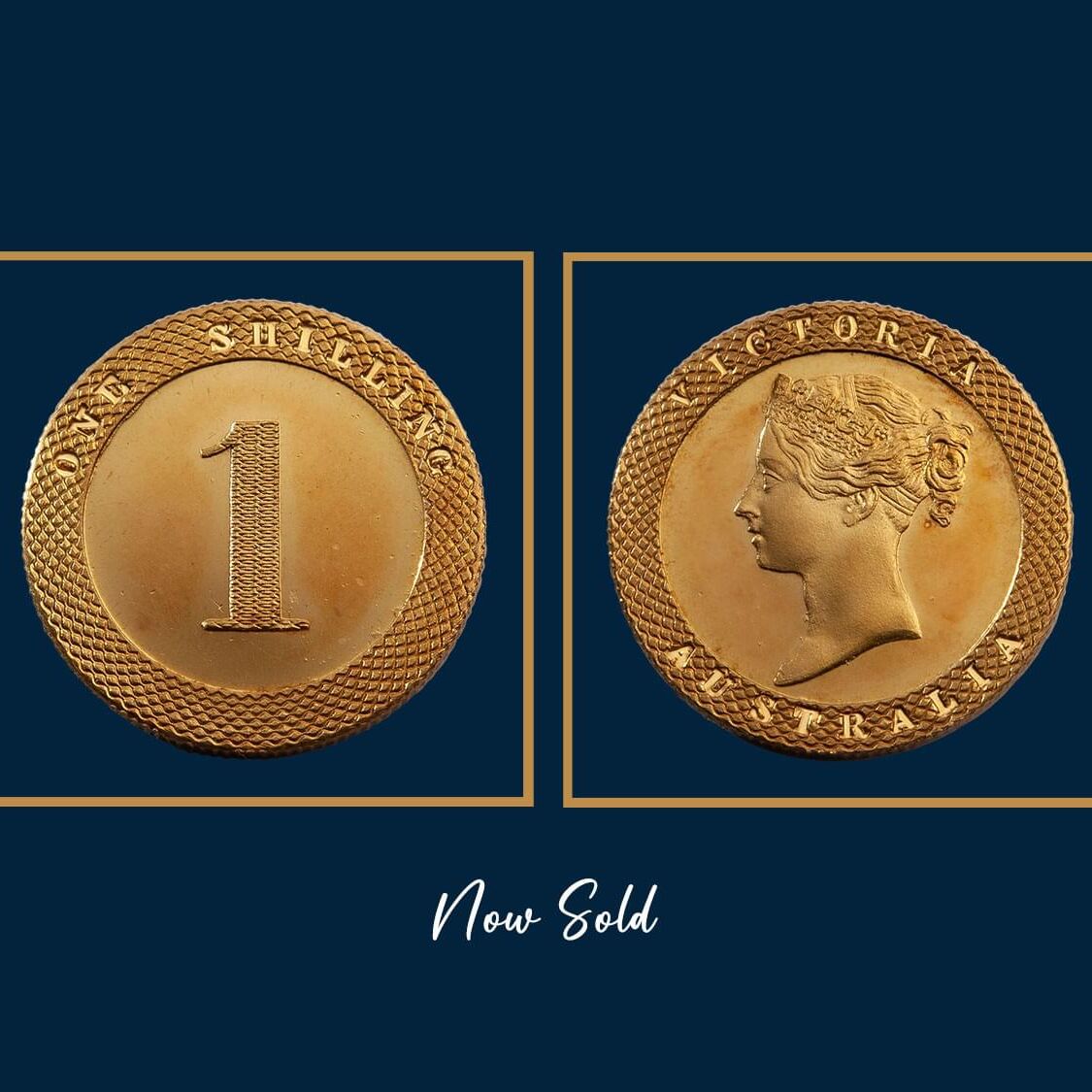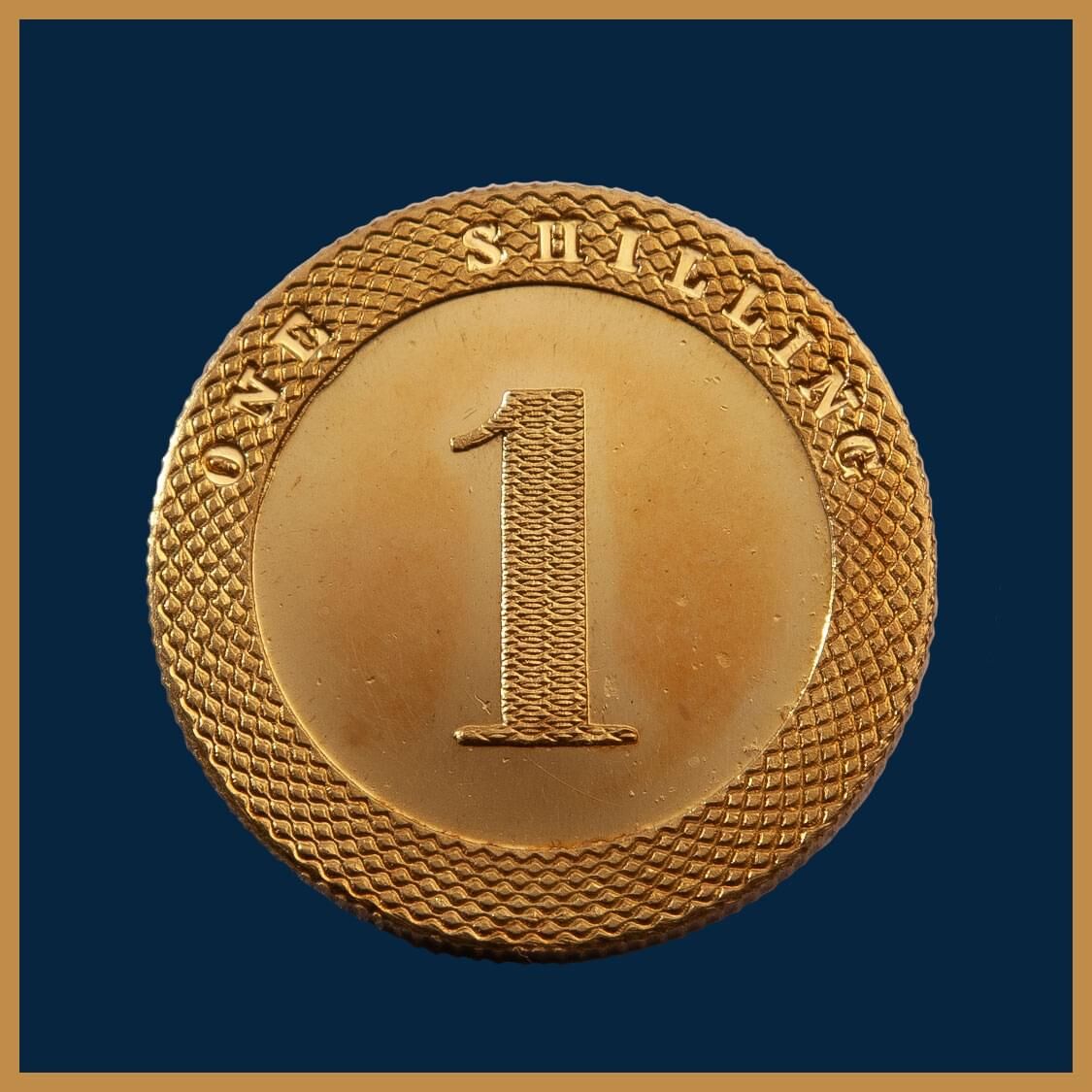Circa 1855, Port Phillip Kangaroo Office Pattern Gold Shilling struck with a grained edge, believed unique.

This Kangaroo Office Gold Shilling was first sighted in London in 1904, as part of the esteemed John G. Murdoch Collection. No other examples are known. Leafing through the bound editions of the early catalogues of 1904 (John G. Murdoch), 1922 (Baron Philip Ferrari La Renotiere) and 1954 (King Farouk), you are in no doubt of the enormous historical and numismatic significance that this piece carries. It embodies history. The Gold Kangaroo Patterns are at the top of their class and this gold shilling is the best in its category, struck with a grained edge indicating that it was minted circa 1855. Exceptional design. Unique style. Rich in history. A piece that has global standing. This Kangaroo Office Gold Shilling is a 'trophy' piece.
In the early days of the Australian Gold Rush, gold was not a standard of value as it was elsewhere in the world. Despite the international gold standard, its purchase value was not fixed but was subject to supply and demand.
The potential of buying gold at a low price was exploited by the banks, buying gold on the fields at rates far below that offered in the towns.
British entrepreneur William Taylor planned to establish a private mint in Melbourne, named the Kangaroo Office. And to challenge the bank's monopoly on the fields. Taylor's plan was that gold, bought at low prices, would be converted into pieces of a fixed weight, a quarter ounce, half ounce, one ounce and two ounce and released into circulation at £1, £2, £4 and £8.
Taylor's first gold issue was dated 1853, the use of a weight value rather than a legal tender value a clever ploy so as not to draw the ire of the colonial Government by striking what was perceived to be 'currency'. Taylor became more venturesome and later, circa 1855, he produced dies for a shilling and sixpence striking them in gold, silver and various other metals.
The sale of the Quartermaster Collection in 2009 was the largest ever offering of Kangaroo Office Patterns, the world over. By lots. And by dollars. Seventeen pieces in total, five produced from gold, six struck in copper and six from silver.
Up until the Quartermaster Auction, the maximum number of gold pieces offered at any one time at an Australian auction had been two.
The Quartermaster Collection held two quarter ounce gold pieces. One gold shilling piece with a grained edge, a gold shilling with a plain edge. And one plain edge sixpence piece. (The milled edge are believed to have been struck circa 1855, the plain edge circa 1860.)
The standout lot of the five gold pieces on offer at the Quartermaster Auction was this Gold Shilling, selling for $305,000, well above its estimate of $250,000. (The plain edge shilling and sixpence also sold well). The quarter ounce pieces, which were expected to shine, sold. But at subdued levels, slightly below their pre-sale estimate, the market showing their overwhelming preference for the 'currency' pieces, the shillings and the sixpence.
The Gold Kangaroo Patterns are at the top of their class and this gold shilling is the best in its category. Struck with a milled edge indicating that it was minted circa 1855. Exceptional design. Unique style. Rich in history. A piece that has global standing.
This Kangaroo Office Gold Shilling is a 'trophy' piece.

Kangaroo Office Gold Shilling,
milled edge

Kangaroo Office Gold Shilling,
milled edge
Technical details Kangaroo Office Gold Shilling
Obverse: A broad raised engine-turned rim encircles a superb portrait of Queen Victoria wearing a jewelled crown, thought to be executed by William Taylor in 1855, and the words VICTORIA and AUSTRALIA incused in the rim.
Reverse: A broad engine-turned rim encircles a large figure ‘1’ in the centre decoratively engraved and the words ONE SHILLING incused in the rim.
Diameter: 22mm
Weight: 8.19 grams
(An engine-turned rim refers to a decorative pattern created by a machine-operated process whereby fine, closely spaced, criss-crossing lines are engraved into a surface. The result is a visually appealing, textured surface that adds a touch of elegance and sophistication.)

Circa 1855 Kangaroo Office Gold Shilling

Circa 1855 Kangaroo Office Gold Shilling
Circa 1855, Port Phillip, Kangaroo Office, Pattern Gold Shilling struck with a grained edge, believed unique.
Soon after the opening of the Adelaide Assay Office in 1852, and the striking of the Adelaide Pound - the nation's first gold coin - there was an attempt to establish a private mint in Melbourne. The mint was called the Kangaroo Office. Its prime goal was to buy gold at cheap prices direct from the fields and convert the precious metal into 'coins' of a fixed weight that would be released at their full value in London.
The plan was devised by English entrepreneur, William Joseph Taylor. By trade Taylor was an engraver and die sinker, active in the numismatic industry producing both coins and medals. He formed a syndicate to finance the operations with two colleagues, Hodgkin and Tyndall. The total investment was £13,000.
Taylor's mint was only one component of a broader-reaching enterprise that was based in London. The overall plan was to profit from all aspects of the Gold Rush and included a clipper ship - called the Kangaroo - that would bring migrants and goods from England to Melbourne and return with gold in its specially outfitted strongroom.
The Kangaroo sailed from London on 26 June 1853. On board, the pre-fabricated structure to house the mint and the shop. And the coining press, dies and two employees, Reginald Scaife, the Manager, and William Morgan Brown, his assistant. The ship arrived at Hobsons Bay, Melbourne on 26 October 1853.
The Kangaroo Office got off to a bad start as there were no facilities at the wharf for off-loading heavy equipment, such as the coining press. With no other option available, the press was dismantled, moved and reassembled, a process that took six months. The Kangaroo Office eventually commenced operations in May 1854, striking gold coins. To thwart currency laws, the designs were made to look more like weights than coins. Taylor himself cut the dies for a 2oz, 1oz, 1/2oz and ¼oz gold piece, each dated 1853.
The coins were exhibited at the Melbourne Exhibition of 1854 (17 October - 12 December) and were written up in the Argus Newspaper as "several tokens of pure Australian gold were exhibited by Mr. Khull, bullion broker. They were manufactured by Mr. Scaiffe and are to be exhibited at our Palace of Industry."(Sadly a price was never quoted.)
Apart from the logistical difficulties of setting up business, the financial viability of the Kangaroo Office came under an immediate cloud. By mid-1854 when the mint became operational the price of gold had moved up to £4/4/- an ounce, vastly different to the £2/15/- per ounce when the plan was hatched. And there was a glut of English sovereigns in circulation.
By the middle of 1854, Reginald Scaiffe, the Kangaroo Office Manager, had an overwhelming sense of failure for the shop had taken less than £1 in trading, he had a ten-year lease, could not find cheap labour. Nor cheap gold. And basically had no customers.
Despite the financial challenges of the operation Taylor was unconvinced that his days as a coin designer and manufacturer were at an end. In 1855 he produced dies for the striking of a sixpence and shilling in gold, silver and copper. This was his first attempt at producing a piece depicting a value rather than a weight. The coins were struck with a milled and plain edge, the former believed minted circa 1855, the latter circa 1860.
The sixpence and shilling featured the same broad engine-turned rim as the earlier minted gold coins. The obverse however featured a superb portrait of Queen Victoria with VICTORIA and AUSTRALIA embedded in the rim. The reverse featured the denomination in figures at the centre and in letters embedded in the rim above.
Taylor operated his Kangaroo Office for three years during which time he sustained substantial losses. With all hope of a profit gone, the dispirited promoters in London issued instructions for the Kangaroo Office to be closed. Now while it is true that Taylor never achieved his ambitions, the Kangaroo Office coins are revered by collectors right across the globe.
© Copyright: Coinworks